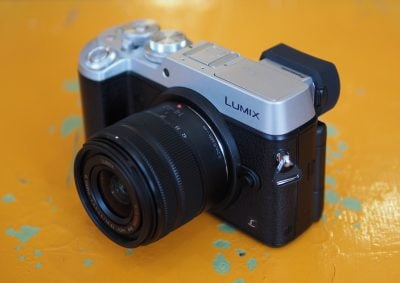Panasonic Lumix GX8 review
-
-
Written by Gordon Laing
In depth
The Panasonic Lumix GX8 is a mirrorless camera aimed at enthusiasts and based in the Micro Four Thirds standard. Announced in July 2015 it replaces the two year-old Lumix GX7 which was the first Lumix body to feature built-in stabilization.
The new GX8 shares the flat-topped style of its predecessors, but is chunkier all-round than the GX7 and now boasts weather-sealing. Like the GX7, there’s an electronic viewfinder in a housing that can angle up by 90 degrees, but Panasonic has sensibly switched the 16:9 LCD viewfinder panel for a 4:3 OLED, and the image is now larger too. As before there’s also a 3in touchscreen, but again the LCD panel of the GX7 has been switched for an OLED, and now the screen is side-hinged and fully-articulated rather than just tilting vertically.
After years of employing 16 Megapixel sensors, the GX8 makes the jump to 20 Megapixels, making it the highest resolution Micro Four Thirds body to date (note the OMD EM5 II can generate 40 Megapixel images, but in a composite process). Like the GX7, the sensor is stabilized, although now offers four axes of compensation and the ability to work alongside OIS lenses (with firmware updates) to further improve performance. As you’d expect, the GX8 also offers 4K video (albeit without body-based stabilization), fast contrast AF with Depth-by-defocus, the choice of mechanical or silent electronic shutters (with a maximum speed of 1/8000 or 1/16000 respectively), and 8fps burst shooting or 6fps with continuous AF. In my in-depth review, I’ve compared its features, quality and handling against rivals from Fujifilm, Olympus and Sony, not to mention Canon and Nikon. Find out which camera will be best for you!
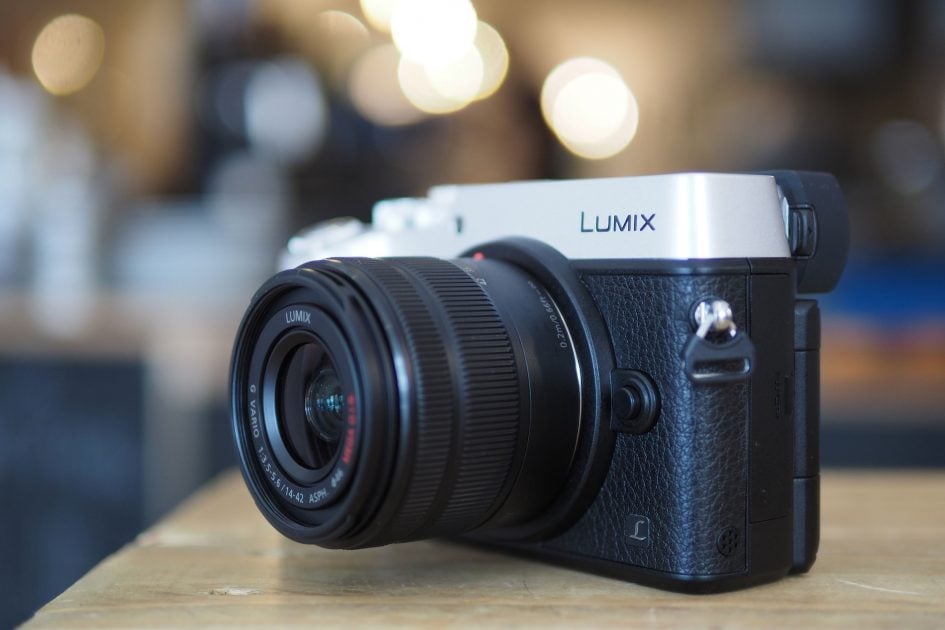
Panasonic Lumix GX8 video review
Panasonic Lumix GX8 design and controls
The Lumix GX8, like its predecessor, is a flat-topped camera with the viewfinder housed in the top left corner as you hold it. While there’s undoubtedly a family resemblance to the GX7 though, the GX8 has grown by roughly a centimeter in each axis, making what was already a chunky camera into something larger still. Indeed measuring 133x78x63mm and weighing 487g (with battery), the GX8 is now in a similar ballpark to an Olympus OMD EM1; sure the viewfinder hump on the EM1 makes it a little taller still, but there’s no longer much between them in overall size. It’s an interesting progression for a series which started-off as being almost pocketable with the original GX1. Note the Olympus OMD EM5 II at 124x85x45mm / 469g, is narrower and thinner, but again a little taller thanks to its viewfinder hump.
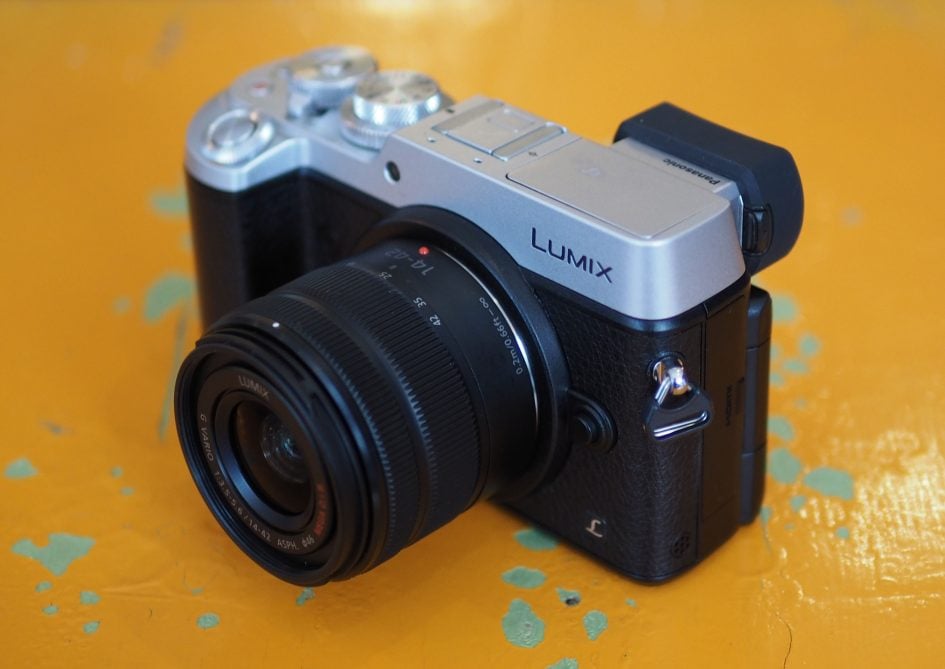
Like the GX7, the shell is magnesium alloy, but Panasonic now quotes the GX8 as being fully weather-sealed with dust and splash proofing. This is a very welcome upgrade and makes the GX8 only the second camera in the current Lumix G lineup to offer weather-sealing, alongside the flagship GH4. I had the camera hanging from my neck during several hours of drizzle and made no attempt to shield it from the elements – I’m pleased to report no issues as a result, although for full protection you’ll need a suitably sealed lens too.
In your hands, the GX8 certainly feels substantial and confident with a generous grip that’s roughly the same depth as the OMD EM1 on the outer edge; so the surface which presses against the palm of your hand is similar in size. But the inner depth of the grip is a little deeper on the EM1, giving more room for fingertips, and I also preferred the coarser rubber textured finish of the Olympus. This is however a purely personal choice. Note the grip on the GX8 is more substantial than the OMD EM5 II.
In terms of controls, there’s quite a few changes from the original GX7. There’s still twin control dials with the finger dial surrounding the shutter release, but the larger grip has allowed Panasonic to shift this control forward from the upper body onto the grip itself – I find this more comfortable than the GX7. Meanwhile the embedded rear thumb dial of the GX7 has been raised to the top surface of the GX8 and exposed in its entirety, although for my taste it remains a little too flush with the rear panel and could also benefit from more defined clicks when turned. Again this is entirely down to personal taste, but I feel the control dials on the OMD EM5 II and especially the EM1 are better-positioned for one-handed operation and provide more tactile feedback when turned.
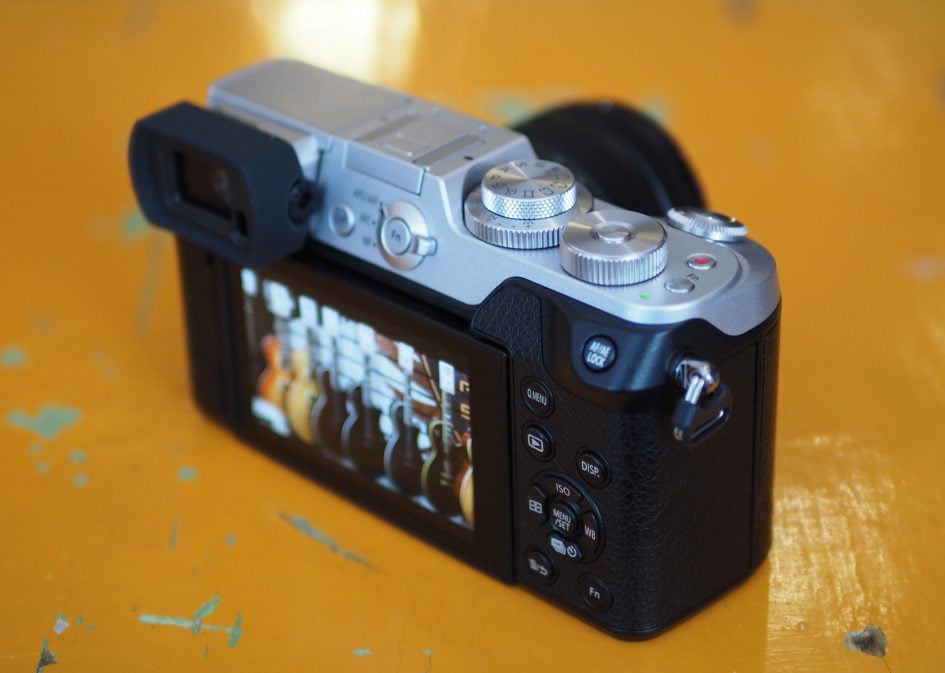
Panasonic has also taken inspiration from the OMD EM1 and EM5 II by allowing you to switch the function of the twin dials. On the Olympus cameras a small switch changes the function of the dials, and on the GX8 a button in the middle of the thumb dial does the same trick. You can customize what the dials do, but by default the button switches them from, say, exposure control to adjusting the white balance and ISO. I feel the switch on the Olympus bodies is ultimately more tactile, but I’m still pleased to find similar functionality here – it quickly lets you double the control offered by the dials.
In terms of customization it’s not just the dials that can be reconfigured. The GX8 has no fewer than 13 customisable function keys: five are soft keys which use the touch-screen, but eight are actual physical buttons. It’s an impressive upgrade over the GX7 which had five soft and four physical function buttons.
Panasonic has also equipped the GX8 with a dedicated exposure compensation dial, positioned under the main mode dial, and a new lever on the rear which switches the camera between focusing modes (like the G7). The combination of all these new buttons, switches and dials makes the GX8 look and feel like a much more serious camera than its predecessor; indeed the older GX7 looks more like a lower-end consumer-focused body in comparison.
In terms of composition, the Lumix GX8 is equipped with an electronic viewfinder and an articulated touch-screen – and both are highlights of shooting with the camera. Like the GX7 before it, the GX8’s electronic viewfinder can be angled up by 90 degrees for composing at an angle if you prefer. But inside the housing there’s several important differences. The GX7 employed a 16:9 shaped, field sequential panel with 2.7 million dots and 0.7x magnification, while the GX8 employs a 4:3 shaped OLED panel with 2.36 million dots and 0.77x magnification.
While the older GX7’s viewfinder image looked big when shooting 16:9 shaped photos or video, it became quite small when cropped to compose in the native 4:3 shape of the sensor, and the effective resolution became lower too. I also found the panel technology suffered from rainbow tearing artefacts when I glanced across it, although I know some people are more sensitive to this than others. But tearing aside, I felt the GX7’s viewfinder was the wrong shape for a camera aimed more at stills than video.
In contrast, the GX8’s OLED panel suffers from no tearing artefacts and matches the shape of the sensor. This coupled with a greater magnification allows the GX8 to deliver not just a noticeably larger and more detailed image than its predecessor, but also compared to most mirrorless cameras out there. It’s in the same league as the Fujifilm XT1 and Sony Alpha A7r II on quality, resolution and size. Sure the high contrast image means noise can become more apparent in shadows than softer panels, but the crispness and vibrancy of the image more than makes up for it.
The main screen is the same size and resolution as before (3in / 1040k dot), but also switches from LCD to OLED technology for a crisper and brighter image. Like its predecessor it remains touch-sensitive, but in a nice upgrade it’s now fully-articulated with a side-hinge that allows it to twist and flip in any direction including forward to face the subject or back on itself for protection. This provides so much more flexibility than the vertical tilt of the earlier GX7 – I find it particularly beneficial when shooting in the tall / portrait orientation at high or low angles.
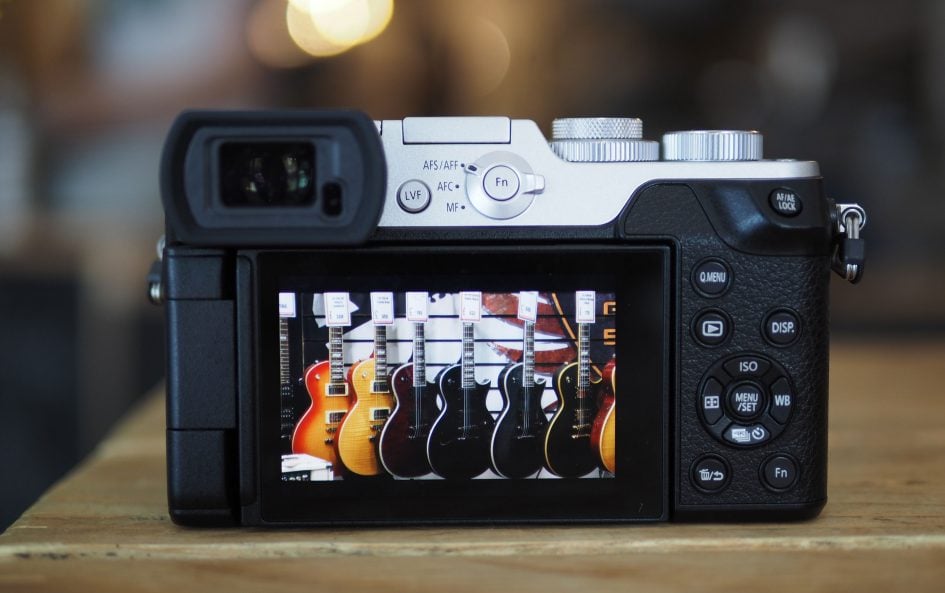
So the greater flexibility of the screen articulation coupled with the considerably superior viewfinder has greatly improved the compositional experience with the Lumix GX8. Normally I get to complain about some aspect of the composition, perhaps the screen isn’t fully articulated or it’s not touch-sensitive, and maybe the viewfinder is the wrong shape or employs an inferior technology. But with the GX8 Panasonic has got it absolutely spot-on. Zero complaints from me for what’s one of the highlights of shooting with the camera.
In terms of connectivity, the GX8 is equipped with a combined USB / AV output, a Mini HDMI port and a 2.5mm microphone jack; it’s a shame there’s not a more standard 3.5mm microphone jack, but at least the GX8 now has microphone connectivity as this was absent on the GX7. In a nice upgrade, the USB port now supports tethering via a laptop, a feature that was previously only available on the GH4, and there’s additionally a new optional USB cabled remote accessory. The GX8 also has Wifi aided by NFC and QR codes to ease the connection, and I’ll discuss this in detail later in the review.
As before the BLC12E battery and memory card are housed together in the grip, positioned just far enough away from the tripod thread so that smaller plates won’t block access. Panasonic quotes approximately the same battery life as before: 340 shots under CIPA conditions, but sadly there’s still no USB charging in-camera. To be fair, Fujifilm and Olympus don’t offer in-camera USB charging on their mirrorless cameras either, but Sony does and I personally prefer the convenience it offers. In mixed use, I typically managed around 200 still photos and a few minutes of video with a little Wifi access on a full charge.
Panasonic Lumix GX8 lenses and stabilization
The Lumix GX8 is equipped with a lens mount that’s compatible with the Micro Four Thirds standard. This gives it access to the broadest and most established catalogue of native mirrorless lenses, including many great quality options from Panasonic and Olympus. While many mirrorless formats are lacking a complete range of lens options, Micro Four Thirds generally offer two or three alternatives at each common focal length – a key advantage over rival systems.
The Micro Four Thirds standard employs a field-reduction factor of two times, so lenses like the standard 14-42mm or 14-140mm kit zooms deliver coverage equivalent to 28-84mm or 28-280mm respectively. The latest Lumix G 14-42mm f3.5-5.6 kit zoom (H-FS1442AE) may not be a collapsing design, but is very compact none-the-less, measuring 49mm in length, 56mm in diameter and weighing 110g. Even the 14-140mm zoom is compact at 75mm long, 65mm in diameter and 265g in weight, making it roughly similar in size and weight to Canon’s EF-S 18-55mm STM kit zoom, but with a 10x range rather than 3x. Here’s the coverage you can expect from the 12-35mm f2.8 premium zoom.

Above: Lumix 12-35mm coverage at 12mm / 24mm equiv (left), 35mm / 70mm equiv (right)
Many kit zooms represent an entry-point to a system – something to get you started before you upgrade to a more capable lens. I’ve found this particularly with many collapsing kit zooms which often trade image quality for size. Panasonic’s Lumix G 14-42mm however is an exception: a lens which may not collapse, but is very compact none-the-less and which importantly delivers much better quality than you’d think for the money, including surprisingly sharp corners. It is in short the best quality small, budget kit zoom I’ve used.
Like other kit zooms, the f3.5-5.6 focal ratio means you won’t be achieving very shallow depth-of-field effects, a fact accentuated by the smaller Micro Four Thirds format. If you desire a nice portrait lens, I can highly recommend Panasonic’s Lumix G 42.5mm f1.7 or the Olympus 45mm f1.8. Check out these and my other recommendations in my Micro Four Thirds lens guide.
One of the biggest differentiating features between Micro Four Thirds cameras from Panasonic and Olympus is the way they handle stabilisation. Panasonic has traditionally preferred optical stabilisation fitted in specific lenses, while Olympus has gradually been refining a body-based system which shifts the sensor to combat camera shake with any lens you attach.
With the earlier Lumix GX7, Panasonic introduced its first body-based stabilisation system which, like Olympus, shifts the sensor to counteract wobbles with any lens you attach. In my tests however it proved lacklustre in performance, only managing a stop or so of compensation compared to four or even five with the latest Olympus system.
Interestingly the Lumix G bodies launched after the GX7 once again relied on optical stabilisation, making me wonder if the company had abandoned body-based stabilisation. But clearly it’s a project for the GX team, as it’s back again on the GX8.
Previously on the GX7, optical stabilisation took priority, so if a lens had it, the body-based stabilisation was disabled. If a lens without OIS was mounted, then the body-based system kicked-in, operating in two axes.
On the GX8, the body-based stabilisation now operates in four axes, but crucially it also works with any existing lens-based OIS. This so-called Dual IS system combines the efforts of OIS and body-stabilisation, but requires that the lens knows about it first with a firmware update. Panasonic explained the latest lenses, such as the 14-42mm and 14-140mm kit zooms, along with the 12-35mm f2.8, 35-100mm f2.8, 30mm f2.8 Macro and 42.5mm f1.7 should all have firmware updates to support Dual IS by August 2015. By the end of 2015, a bunch of other OIS-enabled lenses, including the 42.5mm f1.2 Nocticron and 45mm f2.8 Macro should have updates. Then by February 2016, a further four lenses, including the two Power Zooms should receive their updates. At the time of writing, only three Lumix OIS lenses would not receive the update: the 14-45mm kit zoom, 45-200mm and 100-300mm.
In terms of video, the earlier GX7 didn’t offer any sensor-based stabilisation, instead relying on OIS where present to iron-out any wobbles. Sadly the new GX8 still doesn’t offer sensor-based stabilisation for video, but it does at least now offer electronic stabilisation for video which can work alongside any lenses with OIS. Before you get too excited though, this is only available when filming in 1080p; if you shoot in 4k, there’s no stabilisation unless you’re using an optically-stabilised lens.
Like the GX7 before it, you can enable all available stabilisation or disable it entirely, but there’s no option to disable optical and use body-alone. So the only way to test the effectiveness of the body-based stabilisation in isolation is to fit an unstabilised lens. I tried the Lumix / Leica 25mm f1.4 lens on the GX8 to see the longest shutter speed I could handhold with the body stabilisation disabled and then enabled.
With the body-based stabilisation disabled, I achieved a perfectly sharp result at 1/50 and a pretty good one at 1/25, but any slower and shake ruined the image. With the body-based sensor-shift stabilisation enabled, I still needed 1/50 for a pin-sharp result, as those at slower shutter speeds were a little soft. But while the unstabilised results became unusable at 1/13 and slower, the stabilised ones still looked okay all the way down to 1/6. Once again they weren’t pin-sharp at this speed, but they remained usable at less than full-size and considerably better than the unstabilised ones.
To illustrate this, here’s 100% crops made with stabilisation disabled (on the left) and enabled (on the right) at the same shutter speed of 1/6. As you’ll see the result isn’t pin-sharp with stabilisation, but it’s much better than the version without.

Above: Lumix GX8 stabilisation with Lumix 25mm at 1/6. Body IS off (left), Body IS on (right)
In terms of compensation, I’d say the built-in stabilisation is delivering two to three stops over my unstabilised results at very slow shutter speeds, but sadly none of them could be described as pin-sharp. Better, yes, but perfect, no.
I then tested the Dual IS capability by fitting the Lumix 12-35mm f2.8 lens, updated to firmware 1.3 and zoomed to 25mm to match the coverage of the previous test. As a reminder, Dual IS on the GX8 uses both optical-lens and sensor-shift stabilisation simultaneously.
With the stabilisation disabled, I required a shutter speed of 1/50 for a shake-free result on the conditions of the day. With Dual IS enabled (and confirmed by the icon on the display), I could almost match the result at 1/6, corresponding to just under three stops of compensation; note the 0.3 second result was also pretty good, just not pin-sharp. Here’s 100% crops made with stabilisation disabled (on the left) and enabled (on the right) at the same shutter speed of 1/6.

Above: Lumix GX8 stabilisation with Lumix 12-35mm at 1/6. Dual IS off (left), Dual IS on (right)
I think it’s important to compare the performance with the built-in stabilisation of Olympus bodies, so I repeated the tests with the same lenses. Starting with the Leica / Lumix 25mm f1.4, I found I needed a shutter speed of 1/50 to handhold it steady without stabilisation. With stabilisation enabled, I could achieve the same result at 0.3 seconds and one that was very acceptable at 0.6 seconds. This corresponds to a solid four stops and approaching five under a best-case scenario. Here’s 100% crops made with stabilisation disabled (on the left) and enabled (on the right) at the same shutter speed of 0.3 seconds.

Above: OMD EM1 stabilisation with Lumix 25mm at 1/3. Body IS off (left), Body IS on (right)
With the Lumix 12-35mm f2.8 lens mounted and set to 25mm, I tried three tests: one with the lens stabilisation only, one with the body stabilisation only and one without any stabilisation.
As with the GX8 before it, when stabilisation was totally disabled, I required a shutter speed of 1/50 with the 12-25mm at 25mm for a shake-free result on the conditions of the day. With optical stabilisation on the lens alone, I could match the result at 1/13 and come very close at 1/6; the 0.3 second result was also quite good. With the EM1’s body-base stabilisation alone I could match the result at 1/6 and come close at 0.3 and even 0.6 seconds.
So the lens’s stabilisation alone was good for roughly three stops, while the EM1’s body stabilisation alone was good for three to four stops. Here’s 100% crops made with all stabilisation disabled (on the left), with optical stabilisation only (in the middle), and body-based stabilisation only (on the right), all at the same shutter speed of 1/6. The optical result looks similar to the body result, but judging the entire frame and those at exposures on either side showed the body-based stabilisation to be a little superior with this lens at 25mm.

Above: OMD EM1 stabilisation with Lumix 12-35mm at 1/3. No IS (left), OIS (middle), Body IS (right)
In the example above, I found the EM1’s body-based stabilisation to be slightly superior to the optical stabilisation in the lens alone, but I performed the test for a comparison with the GX8’s figures. Starting with the Lumix / Leica 25mm lens, there’s no contest: the GX8 delivered fair but not perfect results down to about 1/6, whereas I achieved a perfectly shake-free result from the EM1 at 0.3 seconds (one stop slower), and one that was pretty acceptable at 0.6 seconds (two stops slower).
Meanwhile with the 12-35mm at 25mm, the GX8’s Dual IS system gave me an almost perfect result at 1/6, proving it’s about one stop more effective than the optical stabilisation alone (as tested on the EM1). But the EM1’s body-based stabilisation alone alone could match and slightly beat it.
I should also add that the GX8 goes up against the newer OMD EM5 Mark II, which in my tests enjoys roughly one stop more compensation than the EM1, further extending the lead over the Lumix. So while the GX8’s body-based stabilisation seems to perform a little better than its predecessor for unstabilised lenses, while also providing some benefit when working alongside optical stabilisation, it remains a pale shadow of where Olympus currently stands with this technology. Similar to Sony’s built-in IS on the second generation A7 models, it’s certainly better than nothing, but not sufficient to change your shooting style. I do however hope Panasonic continues to develop this technology to not only provide greater compensation in the future, but support for 4k video filming too. Don’t give up.
Panasonic Lumix GX8 shooting modes
The Lumix GX8’s main exposure dial offers the usual PASM modes, along with Creative Movie mode (unlocking all the video options), Panorama, three Custom positions, Creative (with the choice of 22 effects), and the foolproof Intelligent Auto. Unlike the G7 there’s no Scene presets nor a dedicated position on the dial for 4K Photo mode, more of which later. Instead both positions on the dial are devoted to providing additional Custom presets.
Like its predecessor, the Lumix GX8’s mechanical shutter offers speeds between 1/8000 and 60 seconds, but in an upgrade that will be welcomed by long exposure photographers, the maximum Bulb time has been extended from two minutes to 30 minutes. Note the Lumix G7 offers a 60 second to 1/4000 range with a Bulb of two minutes.
Switch the GX8 to its electronic shutter option and the fastest shutter speed accelerates to 1/16000, giving you an extra stop over the top mechanical shutter with the added benefit of operating in complete silence and avoiding any potential shutter shock. This extra stop makes it easier to shoot in bright sunlight at large apertures without having to deploy neutral density filters, and of coruse is ideal for freezing very fast action. Note the slowest shutter speed with the electronic shutter on the GX8 is one second, although the full 100-25600 ISO sensitivity range is available. Here’s a couple of photos taken in bright sunlight at f1.4, exploiting the potential for faster than 1/8000 shutter speeds.

Above: e-Shutter, 1/16000, f1.4, 200 ISO, 25mm f1.4 (50mm equivalent)

Above: e-Shutter, 1//13000, f1.4, 200 ISO, 25mm f1.4 (50mm equivalent)
Electronic shutters do however have some limitations you should be aware of. Most notably their readout time can mean a moving subject could have shifted on the frame before all the data is gathered, resulting in undesirable skewing artefacts; this can also be seen if the camera is panning. I confirmed this to be the case on the GX8’s electronic shutter option even with a slow pan. On previous Lumix models the tonal dynamic range on RAW files was also reduced from 12 bits to 10 bits, although Panasonic claims this is no longer the case on the GX8.
If you understand their limitations though, electronic shutters can still be very useful, not just for being discreet in quiet environments, but also for avoiding shutter shock and shooting with large aperture lenses in bright conditions. I also like to use them during timelapse sequences to avoid the constant sound of the mechanical shutter clicking, and I have an example of this later in this section. It’s a key benefit over most DSLRs which currently don’t offer truly silent shooting options.
With the mode dial set to Creative you can choose from 22 effects on-screen with a preview of how they’ll look applied to the live image. Here’s a selection.
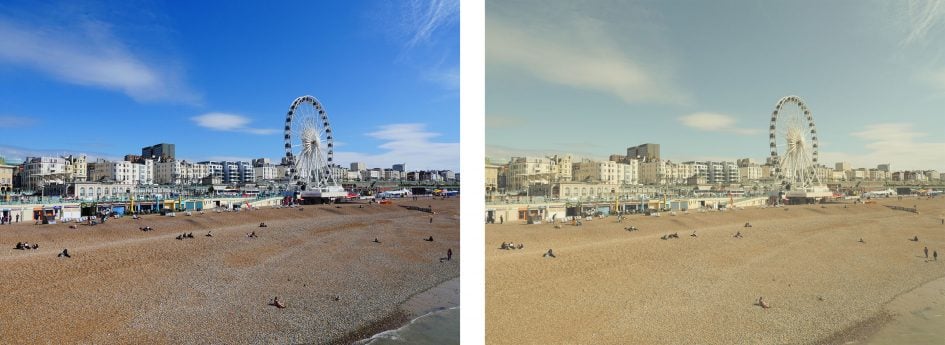
Above left: Expressive effect, above right: Retro effect
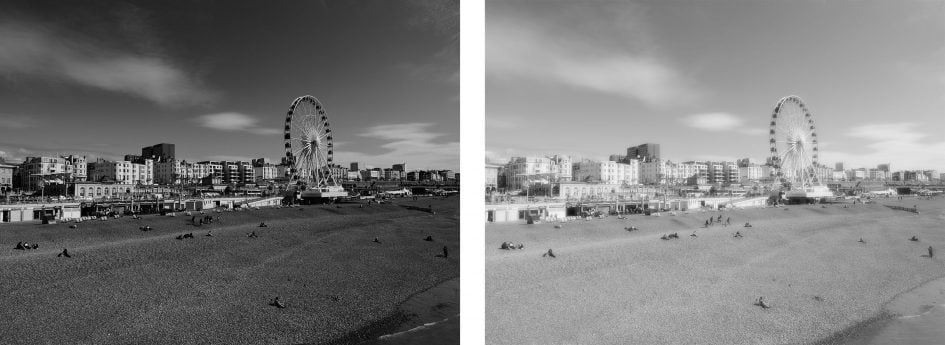
Above left: Dynamic Mono effect, above right: Silky Mono effect

Above left: Cross Process effect, above right: Toy Pop effect
It’s also possible to apply some of the effects to movies which are then encoded at the selected video size up to 1080 / 50p / 60p. Here’s an example of the Miniature Tilt / Shift effect applied to a 1080 / 50p movie.
Above: Download the original file (Registered members of Vimeo only). Here’s the Miniature Effect applied to a movie, by simply choosing the effect then pressing the movie record button. This inherits the selected quality up to 1080 / 60p. 4k movies with effects aren’t possible.
The Panorama option on the mode dial gives you the choice of Standard or Wide image sizes and the chance to pan the camera up, down, left or right. The camera keeps shooting to generate a 360 degree panorama, which can require some practice to keep turning, but you can of course crop the image to the desired coverage. Like earlier models, the GX8 does a good job at blending the exposures, although you can spot multiple instances of subjects in motion, such as birds in flight or people walking by. Here’s two examples below, both taken with the Lumix 25mm lens, first oriented vertically and secondly oriented horizontally.

Above: Lumix GX8 panorama

Above: Lumix GX8 panorama
If you’re recording in JPEG only, the GX8 unlocks its in-camera HDR option which captures three frames at 1, 2 or 3EV intervals before compositing them into a single file. Here’s an example that illustrates how the HDR mode can be used to lift detail in shadows and retrieve it in highlights. Note the minor crop incurred when the camera assembles the images itself.
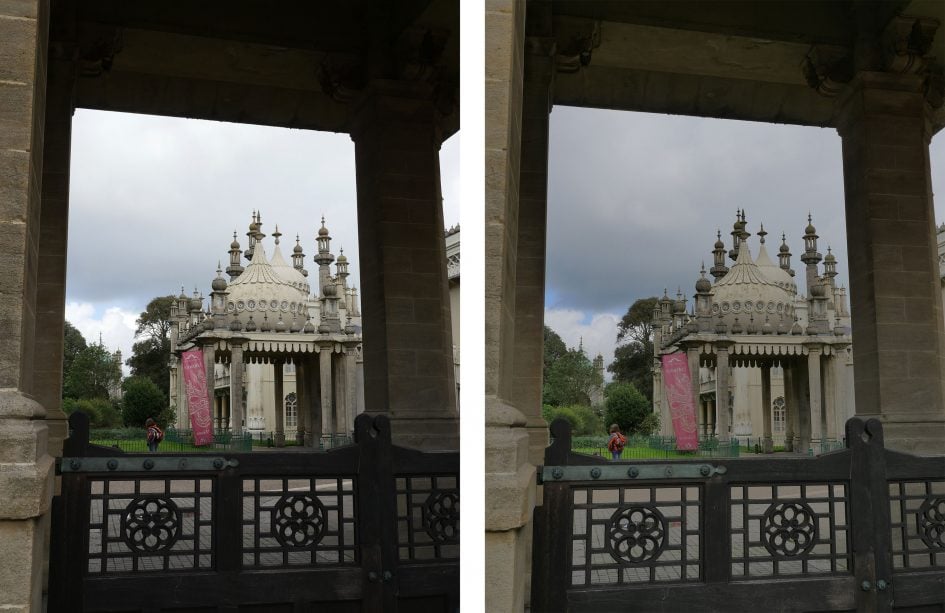

Above: Panasonic Lumix GX8 HDR (disabled, below left / enabled with 3EV range, below right)
If you prefer to generate HDR manually, or simply want to cover yourself, the GX8 is very well-equipped for exposure bracketing with three, five or seven frame options at up to 1EV apart; these can be triggered singly or in a burst, although not in conjunction with a self-timer as they’re on the same menu. Compare this to the paltry three-frame bracketing of most DSLRs at this price point.
There’s also plenty of control over the way the camera processes images, including the chance to adjust tone curves in the Highlight Shadow menu.
Like the G7, the Lumix GX8 offers in-camera Timelapse capabilities with the opportunity to encode the frames into a movie afterwards, in 4K resolution if desired. You can adjust the shooting interval between one second and a second shy of 100 minutes, and for between one and 9999 frames; you can also delay the start to a set time up to 24 hours in advance. Alternatively you can choose the Stop Motion option which relies on you pressing the shutter for each frame when you’re ready – great for making films with toys.
Once you’ve captured the desired number of frames, the camera offers to encode them into a movie; if preferred you can trigger this process during playback later. The video resolutions include VGA, 720p, 1080p (at up to 50p / 60p) and even 4k (at 24 or 25 or 30p depending on region). You can also choose a lower frame rate to stretch your movie length and choose whether to run through the sequence forwards or backwards. You’re welcome to re-run this process as often as you like to create multiple versions.
When capturing the frames, be careful to choose a photo aspect ratio that matches the shape of the desired video, which in most cases will be 16:9, otherwise you may end up with 4:3 shaped video letter-boxed in a 16:9 frame. I’d also recommend reducing the image quality to ensure you don’t run out of space. The Medium resolution (8 Megapixels in 16:9) actually records at the 4k UHD frame size, so is perfect for generating 4k video and unless you intend to manipulate the frames later, you probably don’t need to record RAW either.
Here’s one I filmed on London’s South Bank near to Tower Bridge. I set the camera to take 200 photos at one second intervals, then generated a 4k UHD video at 25fps in-camera afterwards. I shot in Aperture Priority at 100 ISO and f11 which resulted in a shutter speed of around 1/15 to introduce some blurring into the motion. I set the camera to shoot 8 Megapixel JPEGs in the 16:9 shape, and also set the focus to manual to avoid hunting during the sequence.
Above: Download the original file (Registered members of Vimeo only). Sample movie filmed with the Panasonic Lumix GX8 using its Timelapse mode. I set the camera to take 200 photos at one second intervals, then generated a 4k UHD video at 25fps in-camera afterwards. I shot in Aperture Priority at 100 ISO and f11 which resulted in a shutter speed of around 1/15 to introduce some blurring into the motion. The lens was the Lumix 12-35mm f2.8 at 35mm. Note there isn’t an option to crop the photos into a 16:9 aspect ratio, so if you’d like this shape for your in-camera time-lapse videos, you’ll need to remember to set the photo aspect ratio to 16:9 first. I did this and also reduced the quality to 8 Megapixels so not to run out of space, and also set the focus manually to eliminate possible searching during the sequence.
There’s four continuous shooting modes on the Lumix GX8: Low (2fps with Live View), Medium (5.5fps with Live View), High (8fps without Live View) and Super High (40fps but only for a three second burst of 120 frames and at a reduced resolution of 10 Megapixels using the electronic shutter). With Continuous autofocus, the top speed reduces slightly to 6fps reagrdless of whether you’re set to Medium or High, so you may as well go for the former and enjoy Live View. Panasonic quotes ‘more than 30 frames’ when RAW files are being recorded.
Fitted with a UHS-1 card and set to AFS, I fired-off 147 Large Fine JPEGs in High mode in 17.73 seconds before it began to stutter. This corresponds to a speed of 8.29fps. Set to RAW, I captured 36 frames in 4.78 seconds for a speed of 7.53fps before the camera slowed down. Both essentially confirm the top speed and prove there’s plenty of buffer space for long bursts. The speeds are roughly the same I measured for the Lumix G7, but with a deeper buffer. Set to Super High, with the reduced resolution, the GX8 captured exactly 120 frames in exactly three seconds, confirming the 40fps speed.
In terms of bursts with continuous AF, I shot a variety of subjects in motion and found the GX8 recording between four and five frames per second, with generally all of them in focus.
So in single AF with JPEGs, the GX8’s burst shooting slightly exceeded the specifications and in continuous AF it was slightly slower. Sony’s A6000 remains top-dog in this price bracket for continuous shooting, especially since it can rattle-off 11fps with continuous AF, but it’s revealing to note the DSLRs from Canon and Nikon at this price point both shoot at a relatively modest 5fps regardless of AF mode. Since the GX8 roughly matches this for continuous AF and exceeds it for single AF, I’d say that’s a good result for the camera – especially as continuous AF in burst shooting was traditionally an aspect where DSLRs lead. I’ll discuss the AF performance more in a moment.
Like other recent Lumix cameras, the GX8 offers a 4K Photo mode. This exploits the fact 4K video actually contains 8 Megapixels worth of information on every frame, so why not use it for capturing reasonable quality stills at high frame rates? Panasonic’s taken this idea and run with it, making the initial capture and subsequent photo extraction process as simple as possible. There’s three options: Burst (which records video while the shutter button is pressed), Burst S / S (which starts recording with one press and stops with another), and 4K Pre-burst (which keeps a rolling buffer to avoid unwieldy clips to store and go through). I ended up using the Burst mode more often than not.
When you play the capture back, you’re shown a still photo rather than a video clip, with the option to cycle through the frames quickly by oppressing the left or right arrow keys. This makes it very easy to jog back and forth before selecting the perfect moment, after which a press of the Menu / Set button saves the frame as a new JPEG with 8 Megapixel resolution. You can’t save RAW files in the 4K Photo mode, but you can choose the aspect ratio prior to capture along with having full control over the focus, exposure mode, aperture, shutter and ISO.
The 4K Photo mode is great for capturing the perfect moment when faced with fast action, but it’s also surprisingly useful for portraits, especially of kids, where an expression can change between frames. Here’s two shots I extracted from 4K footage, all in-camera.
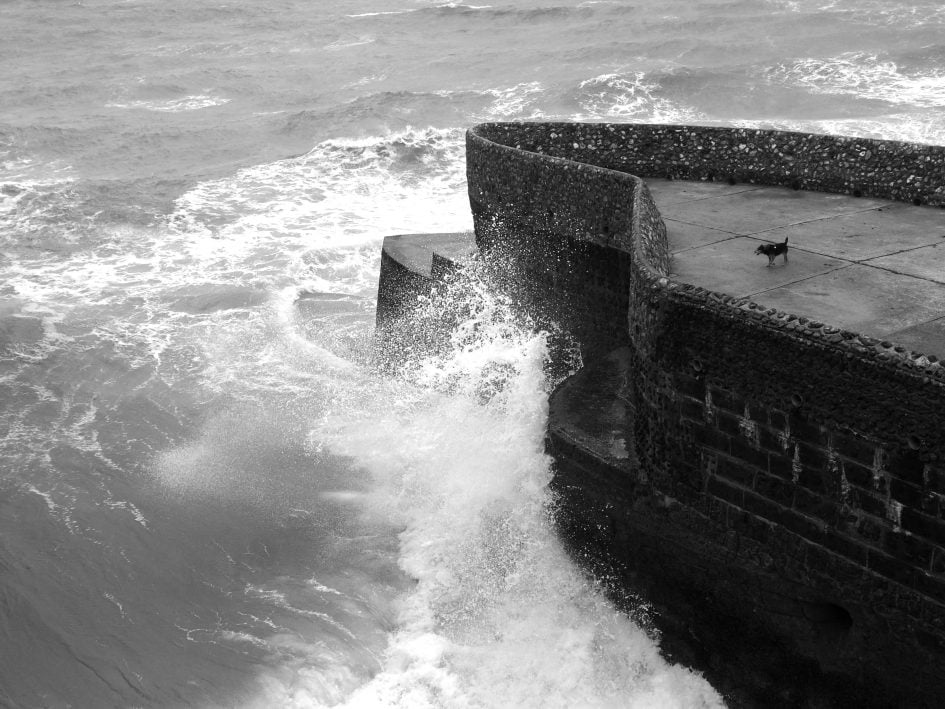

Moving onto focusing, the GX8’s dedicated switch to the right of the viewfinder sets the camera to AF-S (Single), AF-C (Continuous) or MF (Manual Focus). Like previous Lumix G bodies, the GX8 employs a 100% contrast-based AF system with Panasonic once again resisting the opportunity to embed phase-detect points on the new sensor; in this respect Micro Four Thirds bodies, with the exception of the OMD EM1, differ from the vast majority of new mirrorless cameras which now employ hybrid AF systems.
The GX8 lets you choose from six AF area modes: pinpoint, single, Custom Multi (which lets you configure your own zones), 49-Area, Tracking or Face Detection. In each case you can use the touch-screen to reposition AF areas or select subjects, a feature that I really miss on cameras which neglect to offer touch-screens. Panasonic even lets you tap the screen to configure the AF area when you’re composing through the viewfinder. This can be surprisingly useful, but if, like me, you compose with your left eye to the viewfinder, you can inadvertently shift the AF point with your nose. In this instance, it’s best to either flip the screen out or back on itself, or disable the feature. Interestingly Olympus now offers something similar on the OMD EM10 II, but requires you to drag the AF area with your finger rather than simply tapping the screen; this requirement for a prolonged press manages to avoid accidental nasal taps.
As always, the Single AF modes are the highlight of the Lumix G focusing experience. The camera focuses quickly and confidently even if the AF area is dialed-down to its smallest size, and impressively in very low light too. The GX8’s AF system works down to -4EV with a sufficiently bright lens which means it can simply keep focusing in very dim conditions when other cameras become sluggish or give up. It’s an important capability that makes the GX8 very usable across a wide range of lighting conditions. Whether you’re shooting cityscapes at night or exploiting the excellent face and eye detection to capture events, the GX8’s AF system feels very confident.
As a 100% contrast-based system, the Lumix GX8 is never going to perform as well as hybrid systems when it comes to continuous AF. Panasonic’s engineers have worked hard to profile the out-of-focus characteristics of Lumix lenses to better guess where to focus and when to stop, but while this ‘Depth by Defocus’ process is indeed faster than older Lumix G bodies without it, there’s still visible hunting. This in turn can’t help but reduce the success rate when shooting in Continuous AF, especially as the subject moves more quickly.
As with the Lumix G7, I enjoyed fair success using both Panasonic and Olympus lenses for people walking, jogging or casually cycling towards me, but as the speed increased, such as people running or cycling quickly towards me, the GX8 returned a lower success rate. In my tests it was generally fine for kids or pets playing around, but not up to sports played at a higher level. Below is an example of a cyclist approaching at a casual speed which was within the continuous AF capabiliites of the GX8, but anything much faster could see the camera begin to struggle.

Above: 1/5000, f1.4, 100 ISO, 25mm f1.4 (50mm equivalent)
Of the competition, the best mirrorless cameras I’ve tested for effective continuous AF at high burst speeds are Sony’s A6000 and A5100, but it’s important to counter that neither of them offer Single AF that’s as quick or that works in as low light as the GX8. So you have to decide how you’re mostly going to use a camera. Personally speaking I prefer having the quick Single AF and low light performance for the vast majority of my photography.
Set the GX8’s focus dial to MF and you can manually focus the lens with a wealth of visual assistance. You can choose to magnify a portion of the image by up to ten times and either display it full-screen or in a window, allowing you to keep an eye on the entire composition too; this window can also be dragged around by touch if desired. If focus peaking is enabled, the edges of objects are highlighted when they’re in focus, which offers additional confirmation; this works particularly well in conjunction with the magnified view. Peaking is also available for movies, but once you start filming the magnified option becomes unavailable, so you’ll be relying on peaking alone with a full view of the composition; still, it’s better than just judging it visually on the image alone.
Moving on, the GX8 is equipped with Wifi for wireless image transfer and remote control with Andoid and iOS smartphones, and unlike the G7, there’s also the presence of NFC allowing you to initiate a connection with a compatible phone by holding them together for a moment. In the absence (or failure) of NFC, the GX8 falls back to tried and trusted QR codes which work as quickly.
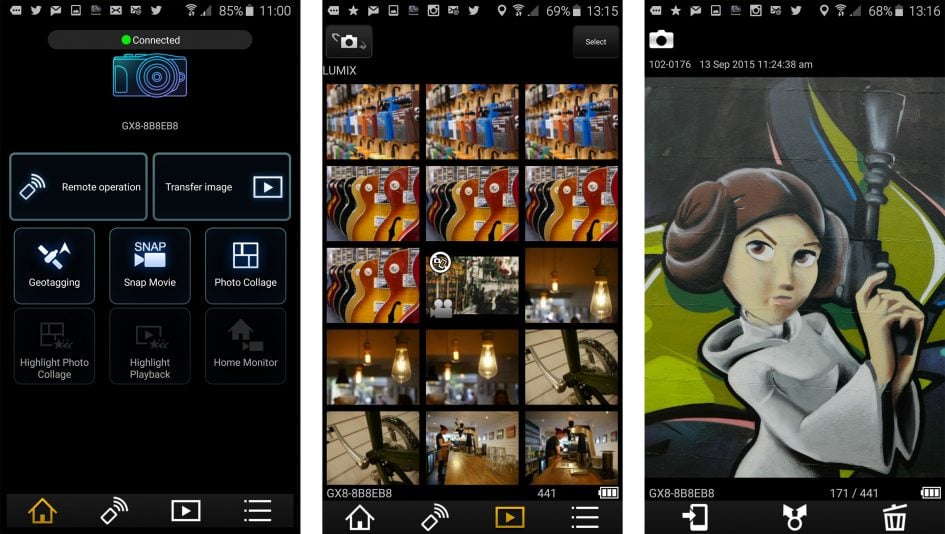
I tried the Lumix Image App on my Samsung Galaxy S6. Like previous versions, this gives you full manual control over the camera with the chance to adjust pretty much anything that’s not set by a physical dial. So while the exposure mode, drive mode and AF mode still have to be adjusted on-camera, the app lets you set the photo and video quality, aperture, shutter, ISO, white balance, exposure compensation and AF area. You can tap to reposition the AF area too, with or without triggering the shutter. You can start and stop video recordings of any quality via the app, and also tap the phone screen to pull-focus while filming.
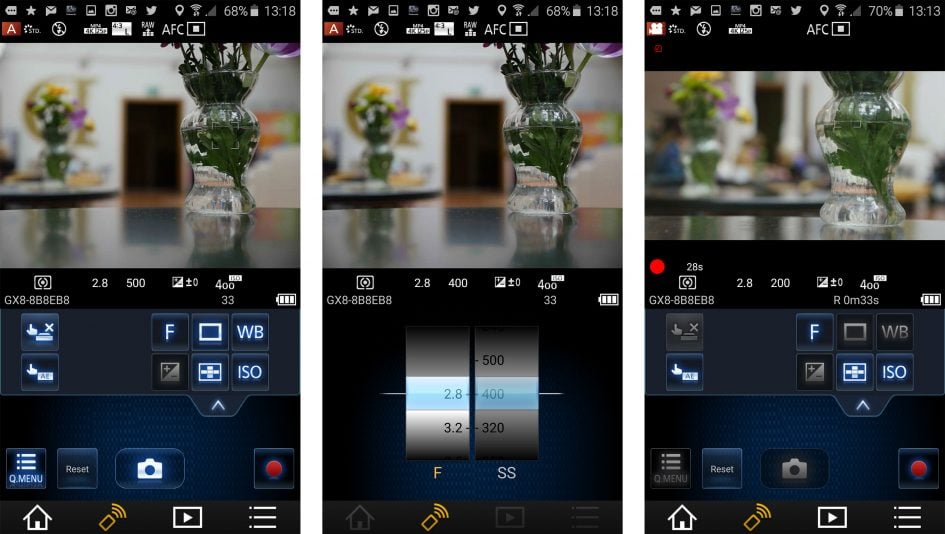
During playback you can view thumbnails of stills and videos. JPEGs can be copied onto the phone over Wifi, but not RAW files. Videos can be streamed from the camera and played on the phone’s screen, including those recorded up to 4K resolution. You can also use the app to copy videos to your phone, although only up to 1080p quality.
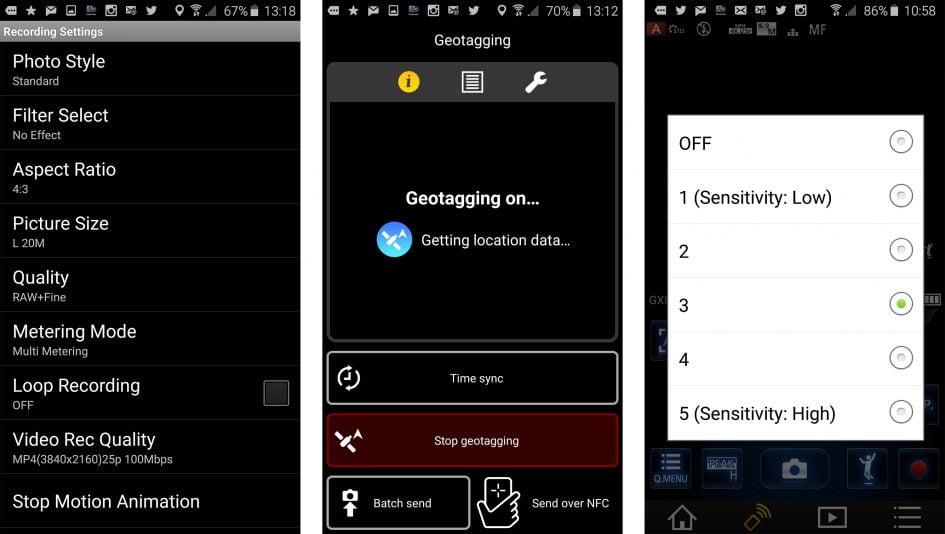
The app also lets you record a GPS log for later syncing with images in the camera, a process that involves wirelessly copying a log to the camera, before using the camera’s playback menus to apply it to relevant images in that timeframe. Here’s an example I tagged of Tower Bridge in London, using a GPS log made in my Galaxy S6, followed by a screengrab of the co-ordinates entered into Google Maps.

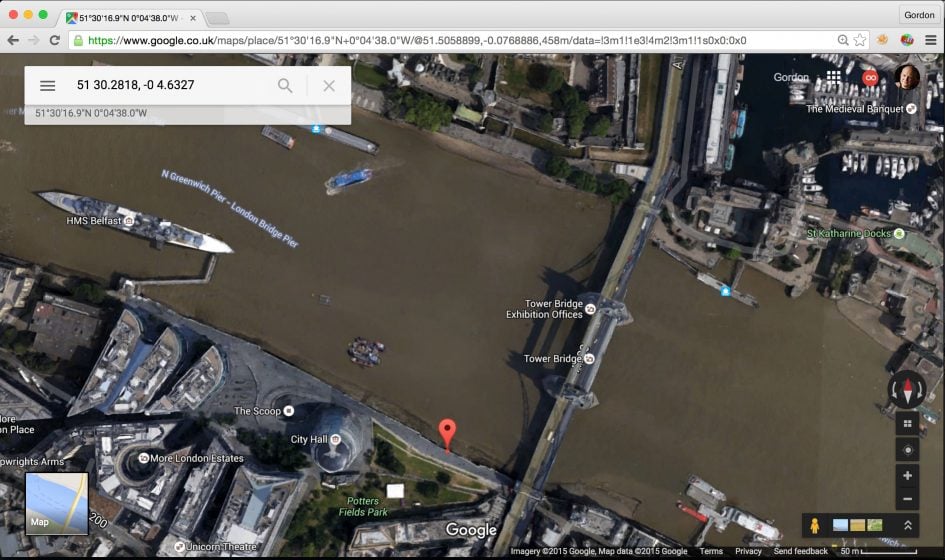
It’s also possible to send image direct from the camera to a variety of social services, including Facebook, twitter, Youtube, Picasa and Flickr. To do so you’ll first need to sign-up for Panasonic’s Lumix Club and grant it permission to post on your behalf – so when sharing to, say, Twitter, the camera sends the image via the Lumix Club. It’s not as neat as Sony’s solution which appears to post direct from the camera, but it’s fairly standard for most Wifi-equipped cameras.
Finally, the Lumix Image app allows the GX8 to inherit the fun Jump Snap feature introduced with the GF7. This uses the accelerometer in your phone to trigger the shutter remotely as you jump in the air. It works surprisingly well too. Using the app you can remotely view the composition and refocus the camera if necessary, before then setting the sensitivity of the jump detection. After a little fine-tuning of the sensitivity you’ll be able to capture the perfect moment when you’re at the top of your leap. It’s a really fun way to exploit the technology in your pocket.
Panasonic Lumix GX8 movies
The Lumix GX8 essentially matches the recent G7 for video capabilities, offering 4k capture, full control over exposure, silent screen-based adjustments, flat profiles, focus peaking and zebra patterns. 4k UHD video is available at 24p and either 25p or 30p depending on region, all at 100Mbit/s. Alternatively you can capture 1080 at 50p / 60p at 28Mbit/s, or at 25p / 30p at 20Mbit/s. 720p and VGA options are also available. The maximum recording time on all models, whether in Europe or not is 29:59. Sadly the body-based stabilisation is not available for video. A new electronic stabilisation mode is offered for 1080p, but not at all for 4k – so if you want stabilised 4k footage, you’ll need to use an optically stabilised lens.
You can start recording in any exposure mode by simply pressing the red record button, but for the most control and options you should turn the mode dial to Creative Video which lets you film in the choice of PASM modes with full control over exposure. The sensitivity for movies is selectable between 200 and 6400 ISO, and there’s an Auto ISO option too, although sadly not when shooting in full Manual mode.
The touchscreen is well-used for movies: it’s possible to tap to pull-focus between subjects when filming, either automatically if Continuous AF is enabled, or as soon as you half-press the shutter release if it’s disabled. Tapping the screen also pops-out a tray of controls, allowing you to silently adjust the aperture, shutter speed, ISO, exposure compensation or microphone level all while filming, depending on the mode.
A variety of processing parameters can be adjusted within the Photo Styles, including sharpness, contrast, saturation and noise reduction. There’s also the Cinelike V and Cinelike D profiles inherited from the GH4, the latter offering fairly flat output for grading later (plus you can dial-it down even further if desired). You can also choose between 0-255 and 16-255 for the Luminance Level, the former being preferrable if you intend to capture the best-looking stills from footage.
Audio is recorded using either the built-in stereo mics, or an external microphone connected to the 2.5mm jack. Stereo level meters can be displayed and the level adjusted in fine increments, but there’s no headphone jack.
The Extra Teleconverter option works in all but the 4K modes, taking a 1:1 crop from the middle of the frame at the selected video resolution and therefore providing a tighter view without degradation in quality; neatly the 1:1 crop also better avoids moire effects. When filming in 1080p, the Extra Teleconverter effectively applies a 2.39x field reduction.Â
Here’s screengrabs from footage filmed in 1080p with the Leica Lumix 25mm f1.4, with the teleconverter disabled below left and enabled below right. Below these are 100% crops from the area in the middle of the frame where it’s clear the Extra Teleconverter option is delivering genuinely greater detail rather than just cropping and enlarging.
Like previous Lumix cameras, the GX8 deploys different crops depending on whether you’re filming in 1080 or 4k. When filming 1080, the GX8 takes the full usable sensor width of 5184 pixels and scales it down to 1920 pixels. So the horizontal field of view when filming in 1080 is identical to shooting stills, but of course the uneven scaling factor means there’s also artefacts to deal with.
This is the same approach shared by the Lumix G7 and GH4 before it, but 4k UHD footage is treated differently on each model. On the GH4, an exact 3840×2160 pixel crop is taken from the middle of the 4608×3456 sensor and encoded without scaling. On the G7, a less severe crop of about 4120×2318 pixels is made from the 4592×3448 sensor, then scaled-down to 3840×2160 to generate a 4k UHD frame. As a less severe crop than the GH4, the G7 enjoys wider coverage with the same lens, but the footage is susceptible to scaling artefacts.
Meanwhile the Lumix GX8 starts with a larger sensor resolution of 5184×3888, from which it takes a crop measuring around 4132×2324 pixels, before then scaling it down to 3840×2160 pixels to generate a 4k UHD frame. To calculate and illustrate the difference in coverage I compared actual 4k footage I filmed with the GX8 against still photos when using the same lens and position. In the image below, the 4k coverage is indicated by the outer edge of the red frame, resulting in a not insignificant reduction in the field of view.
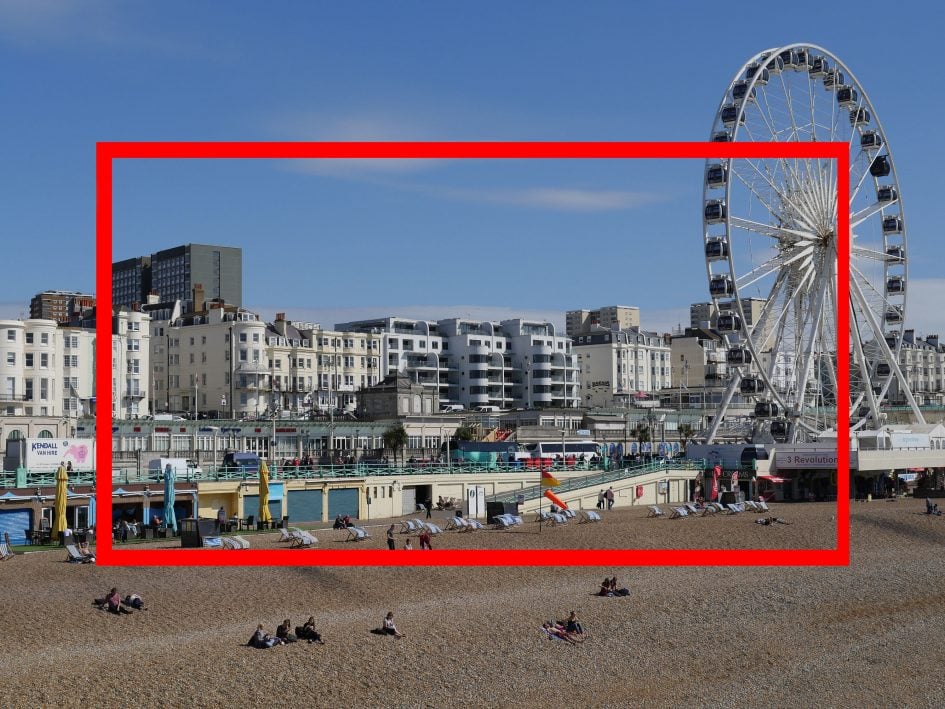
Above: Lumix GX8 movie coverage. 4k crop indicated by outer edge of red frame
By my calculations using actual footage filmed with all three cameras, the GX8’s horizontal field-reduction for 4k UHD video works out at about 1.25x, compared to about 1.1x for the Lumix G7 and 1.2x for the Lumix GH4. So given the same lens on each model, the GX8 will deliver the narrowest view and the G7 the widest, with the GH4 roughly inbetween. Here’s how the GX8 crop looks for 4k video, below left, compared to 1080p video, below right.

Above: Lumix GX8 movie coverage, 4k (left), 1080p (right)
It’s clear from the views above that filming in the 1080 modes captures a wide field of view, but how does the quality compare? I could have simply taken crops from the footage above, but they weren’t starting on a level playing field. So I fitted the Lumix 12-35mm f2.8 zoom and adjusted it so I captured exactly the same field of view when filming in both 4k UHD and 1080. Below are 100% crops made from the 4k footage on the left and the 1080p footage on the right. Remember both are taken from clips which share exactly the same field of view.

Above: Lumix GX8 movie quality. 4k (left), 1080p (right). Both 100% crops
It’s pretty clear from the crops above that the 4k footage on the left genuinely contains greater real-life detail than the 1080 footage on the right. Fine details in the grills, vents and railings are much better resolved on the 4k footage, and while the flagship GH4 better-avoids moire thanks to its lack of scaling, the GX8, like the G7 before it, does a fair job. Of course everyone’s expectations are different, so I’d encourage you to download the original clips for yourself and play them back on a native 4k display. Here are the links to the originals: Panasonic Lumix GX8 4k test clip with 12-35mm / Panasonic Lumix GX8 1080p test clip with 12-35mm.
Now here’s a selection of other clips to demonstrate the G7’s video performance in various conditions.
Above: Download the original file (Registered members of Vimeo only). Sample movie filmed with the Panasonic Lumix GX8 in its 4k UHD / 25p mode with the Standard Style and 100 Mbit compression. The camera was set to 200 ISO, and the lens was the Lumix 25mm f1.4 at f4. I also have a version filmed in 1080 / 50p to compare the coverage – see my Lumix GX8 daylight 1080p movie – and also a version filmed with the Cinelike D profile for later grading – see my Lumix GX8 daylight 4k Cinelike D movie.
Above: Download the original file (Registered members of Vimeo only). Here’s how the GX8 looks when filming 4k UHD at its maximum movie sensitivity of 6400 ISO. I also have clips at 3200 and 1600 ISO, see my Lumix GX8 4k at 3200 ISO movie and Lumix GX8 4k at 1600 ISO movie. If you’d like to compare the quality in 1080p, check out my Lumix GX8 1080p at 1600 ISO, Lumix GX8 1080p at 3200 ISO and Lumix GX8 1080p at 6400 ISO clips.
Above: Download the original file (Registered members of Vimeo only). In this clip I tested the continuous AF capabilities of the camera by pointing it between near and far subjects. Sample movie filmed with the Panasonic Lumix GX8 in its 4k UHD / 25p mode with the Standard Style and 100 Mbit compression. The camera was set to 400 ISO, and the lens was the Lumix 12-35mm f2.8 at 35mm f2.8.
Above: Download the original file (Registered members of Vimeo only). In this clip I tested the focus-pulling by touch, using the screen. Sample movie filmed with the Panasonic Lumix GX8 in its 4k UHD / 25p mode with the Standard Style and 100 Mbit compression. The camera was set to 400 ISO, and the lens was the Lumix 12-35mm f2.8 at 35mm f2.8. I also have a version where I remote-control the focus-pulling using the Lumix Image App running on my phone. See my Lumix GX8 remote focus-pulling movie.
Panasonic Lumix GX8 sensor and results!
Which brings me to the sensor itself which, for the first time in about four years, upgrades the resolution. Back in 2011 we saw Micro Four Thirds jump from 12 to 16 Megapixels, and now with the GX8 in 2015 it increases to 20.3 Megapixels. This generates images measuring 5184×3888 compared to 4592×3448 on the Lumix G7 or 4608×3456 on the OMD EM5 II. This gives the GX8 approximately 600 pixels more in length and 400 pixels more in height than previous 16 Megapixel models, allowing you to print roughly two and a half inches larger on the diagonal. It corresponds to about 15% greater resolving power. In theory anyway.
To see how the GX8 performs in practice I testcd it alongside the Olympus OMD EM10 II, Fujifilm XT10 and Sony A6000 for both resolution in daylight and noise in low light. So to see how they compare, check out my Lumix GX8 quality results, Lumix GX8 sample images. Alternatively if you’ve already seen enough, skip back to my verdict!
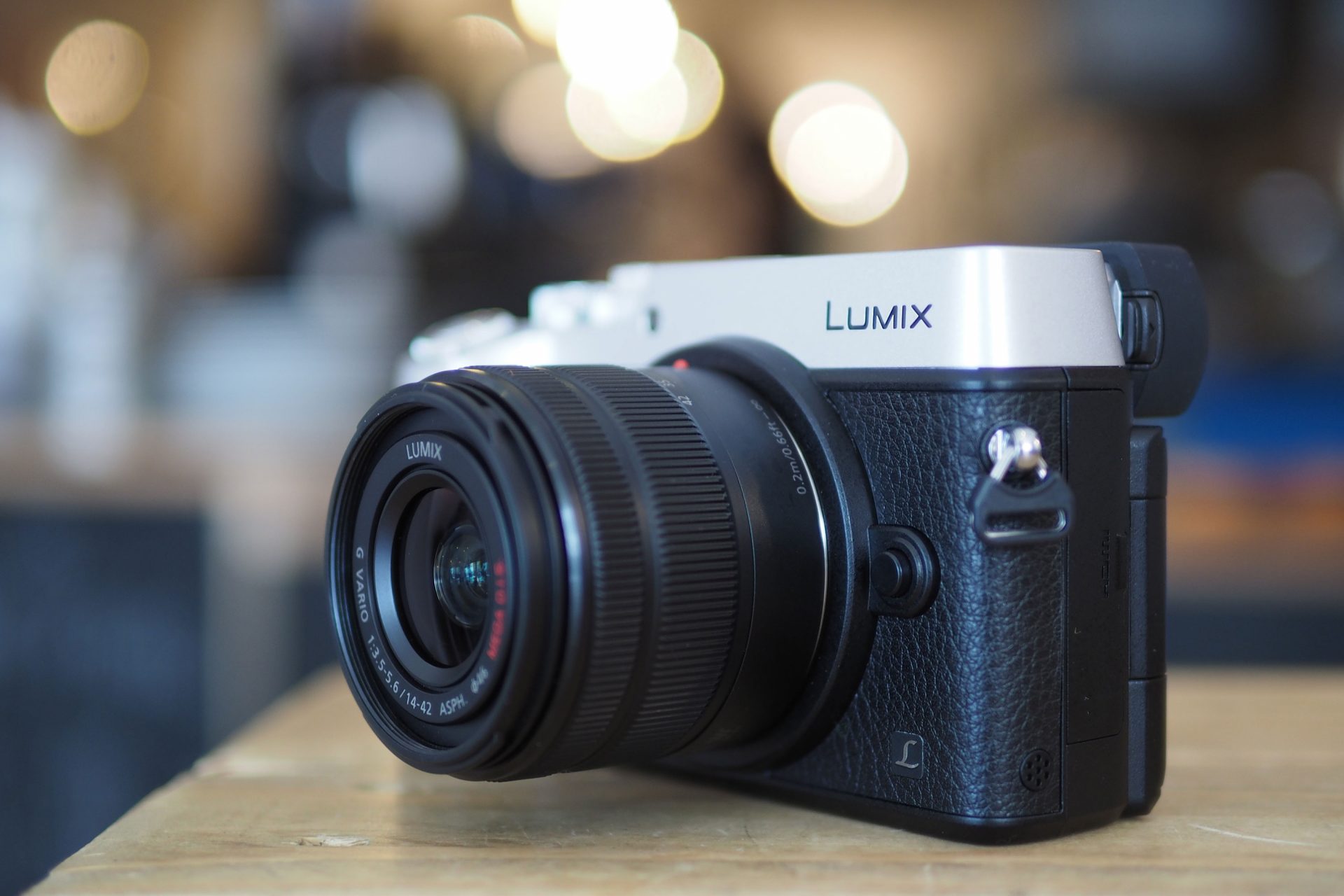
 Panasonic's Lumix GX8 is an up-market mirrorless camera that satisfies the desires of demanding enthusiasts, especially if they're into video. It builds-upon the earlier Lumix GX7 to become a more sophisticated camera that confidently competes with rivals including the Olympus OMD EM5 Mark II and Fujifilm XT1 at the upper-end of the non-full-frame market. I particularly liked the large and detailed OLED viewfinder and fully-articulated OLED touch-screen on the GX8, along with its weather-proofed body. The presence of 4k video and 4k photo capture may now be normal for Panasonic, but remains a valuable and unique capability.
Panasonic's Lumix GX8 is an up-market mirrorless camera that satisfies the desires of demanding enthusiasts, especially if they're into video. It builds-upon the earlier Lumix GX7 to become a more sophisticated camera that confidently competes with rivals including the Olympus OMD EM5 Mark II and Fujifilm XT1 at the upper-end of the non-full-frame market. I particularly liked the large and detailed OLED viewfinder and fully-articulated OLED touch-screen on the GX8, along with its weather-proofed body. The presence of 4k video and 4k photo capture may now be normal for Panasonic, but remains a valuable and unique capability.



